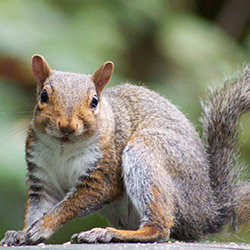
Squirrel Control, Trapping & Removal Services
We can rid you of Squirrel problems safely and efficiently
Did you know the United States is home to over 200 species of squirrels? Common members of the squirrel family include ground squirrels, tree squirrels, chipmunks, marmots, prairie dogs, and flying squirrels. Texas is home to just eight squirrel species.
Common Squirrel Issues
Some common squirrel issues in Dallas include:
- Disease transmission (like rabies and Lyme disease)
- Home damage
- Squirrel poop
If you have woken up to the sound of scampering above your head in the early morning, this could be a sign that you have squirrels in your Dallas attic. Call the professional squirrel removal specialists at Trutech of Dallas before you invest time and money on potentially hazardous DIY squirrel control. We have the skills and equipment to effectively and humanely address squirrel problems of any size (whether live or dead).
Squirrels in the Walls?
These fluffy-tailed critters are infamous climbers and can easily get into homes in neighborhoods, by way of overhanging tree branches and by scampering across power lines. These clever rodents are talented at finding holes through which to enter, and as avid chewers, are determined to chew through tough material in order to gain entry. Squirrels often take up residence in wall voids, because they’re isolated and warm.
As soon as a squirrel has established a nest, they will begin to leave signs of their presence, including feces, which can cause unbearable odors. Other indications of their presence includes vocalizations such as squeaking, and noises of movement like scratching or chewing. If a squirrel dies inside your wall, you will need to call a professional squirrel control team to remove the carcass and deodorize your home.
Though they’re so common outdoors that some don’t even consider them to be home invaders, squirrels can be a serious threat to the safety inside your home. Piles of squirrel feces can spread various diseases such as salmonellosis and leptospirosis.
Dealing with Squirrels in the Attic?
Squirrels may also choose to make their nest in another cozy area of your home—your attic.
Our skilled squirrel technicians are dedicated to helping your regain your comfort and your property. Don’t wait until it’s too late and squirrels have caused serious damage to your Dallas yard, home, or sanity. Contact the specialists from Trutech Dallas to implement humane squirrel removal and control plan to get squirrels out of your walls or garage!
APPEARANCE
Tree squirrels are typically 1–2 feet long and have big, bushy tails that act as a balancer while they climb and jump across treetops. Their fur can be black, gray, brown, or rusty red. Ground squirrels are traditionally red–smoky gray in color and often show striped or spotted patterns. Ground squirrel tails are significantly shorter/thinner than tree squirrels’. Flying squirrels are tan/gray with lighter bellies and black stripes along their sides.
DIET
Tree squirrels and flying squirrels are primarily herbivores, enjoying nuts, seeds, grasses, roots, and other plant materials, but flying squirrels have been known to also eat birds, eggs, and insects. Squirrels’ omnivorous nature leads them to find food sources wherever they are available, often targeting bird feeders and garbage.
HABITAT
Tree squirrels and flying squirrels are most comfortable nesting in wooded regions with lots of trees and ground cover. Their nests are made of leaves and small twigs in high areas of trees or inside tree holes. Ground squirrels, as their name suggests, are often found nesting in open areas like meadows. They dig tunnels and burrows to live in.


